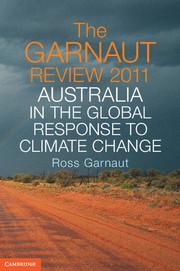Chapter 11 - Electricity transformation
Published online by Cambridge University Press: 05 January 2012
Summary
In 1865, William Stanley Jevons, a founder of modern economics as well as meteorology, published a book called The coal question. In it he drew attention to the United Kingdom's limited coal supplies and commented that ‘if we lavishly and boldly push forward in the creation and distribution of our riches, it is hard to overestimate the pitch of beneficial influence to which we may attain in the present. But the maintenance of such a position is physically impossible’.
Jevons did some of his seminal work in Australia and his words have a special resonance for contemporary Australians. The largest source of Australia's disproportionately high greenhouse gas emissions is our reliance upon coal in the electricity sector. As such, we face the same choice outlined by Jevons. We might elect to do nothing and continue to enrich ourselves, in part with cheap energy. But in the long run climate change ensures that the maintenance of our current prosperity under business as usual remains impossible. The transformation of Australia's electricity sector is thus about ending reliance on fossil fuel long before the coal runs out—unless we can capture and safely store the carbon dioxide wastes. Australia's unusually emissions-intensive electricity sector is the main reason why Australia's emissions per person are exceptionally large.
The transformation of the electricity sector has to be at the centre of Australia's transition to a low-emissions economy for this reason, and also because the lowest-cost path to reducing emissions in the transport, industrial and household sectors involves greater use of low-emissions electricity.
- Type
- Chapter
- Information
- The Garnaut Review 2011Australia in the Global Response to Climate Change, pp. 149 - 165Publisher: Cambridge University PressPrint publication year: 2011
- 1
- Cited by



